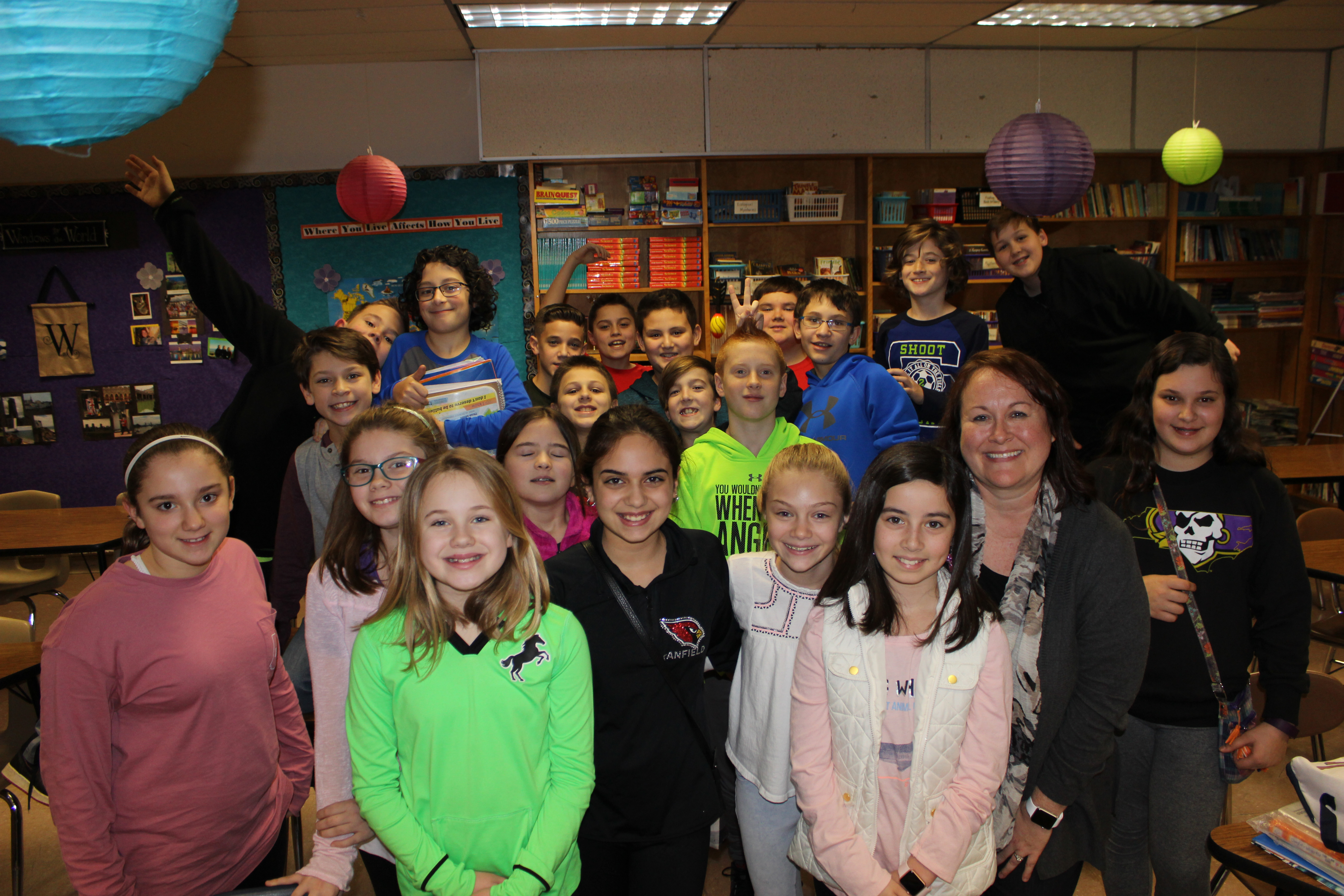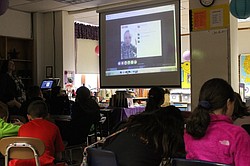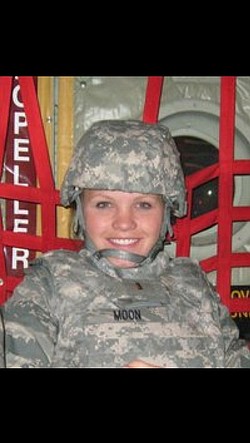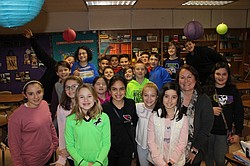
Neighbors | Abby Slanker.Fifth-grade students at Canfield Village Middle School enjoyed a ‘visit’ to their classroom from Captain Katrina Moon, a bioastronautical engineer, Jan. 26. Science teacher Valerie Weingart invited to speak to her students through Facebook Live.
Neighbors | Submitted.Captain Katrina Moon, a bioastronautical engineer who spoke to Canfield Village Middle School students from space on Jan. 26, is pictured.
Neighbors | Abby Slanker.Canfield Village Middle School fifth-grade science teacher Valerie Weingart’s class sent a big thank you to Captain Katrina Moon, a bioastronautical engineer, who spoke to them about space from the Air Force Academy through Facebook Live Jan. 26.
By ABBY SLANKER
Fifth-grade students at Canfield Village Middle School enjoyed a ‘visit’ to their classroom from a bioastronautical engineer on Jan. 26. Science teacher Valerie Weingart invited Captain Katrina Moon to speak to her students from the Air Force Academy in Colorado. Capt. Moon spoke to the students through Facebook Live.
Capt. Moon is a United High School graduate and has a master’s degree in bioastronautics and is currently an astronautical engineer instructor at the Air Force Academy. Moon has worked with satellites in space and researched the effects of human bodies in space. The students are studying a unit on Earth and space.
Capt. Moon gave the students a little bit about her background and how she got to where she is today.
“When I was your age, I didn’t like math. I didn’t understand it and it was hard for me. Luckily, for me, my dad helped me understand math and eventually I got really good at it and it became my favorite subject. I wanted to go to college and was looking for a way to pay for it. I was accepted to the U.S. Naval Academy in Maryland, where students go to college, but also receive military training. And one great benefit is they pay you to go there, so don’t have any bills to pay. When you graduate, you are an officer in the military and because they paid for your schooling, you have to commit to the military for five years,” Capt. Moon said.
Capt. Moon explained the beginnings of her military service.
“I became an officer in the Air Force. My first job was as an engineer in the Air Force, working on F16 jet engines. Later I was deployed to Afghanistan to do my job as an engineer. It was really a great experience for me. Then I became a nuclear missile engineer and then a satellite operations engineer. Then I earned my masters in bioastronautical engineering. Right now I am a professor in the Air Force Academy Astronautical Department where I teach cadets about space,” Capt. Moon told the students.
Capt. Moon then talked about the biggest myth in space, the lack of gravity.
“There’s actually still a lot of gravity in space. The farther you get away from Earth, the less you feel the force of gravity, but it’s still there.
Astronauts are in what we call free fall and they are actually floating and really having lots of fun,” Capt. Moon explained.
Capt. Moon explained to the students how much the astronauts’ bodies change in space.
“Your body changes based on the environment you are in. Astronauts’ bodies adapt to the free fall environment in space by sending a message to not send calories to their muscles and calcium to their bones. Their bones decalcify, which means their bones get weaker and weaker. Then their bodies decide they don’t need muscles because the astronauts are floating all the time, so their muscles get smaller and atrophy. The astronauts become kind of like jelly fish. Their hearts also don‘t have to work as hard and get weaker,” Capt. Moon said.
Capt. Moon explained that the astronauts exercise in space so they can be healthy when they come back to Earth.
“The astronauts exercise in space. They exercise two hours a day. It’s a challenge for them to exercise up there, so we had to come up with some creative ways for them to do it. For example, on a treadmill, the astronauts have to wear a harness and bungie cords hold them down so they can actually run on the treadmill,” Capt. Moon said.
Capt. Moon also explained to the students the diet of astronauts in space and how they sleep in space, without floating away, and how all of this is a challenge for the engineers so the astronauts can do these things with ease. She also explained that astronauts practice a lot before they go up in space so they can experience what life will be like in space.
“The astronauts have to eat healthy food in space, so the engineers had to come up with really creative ways to cook their food. All the astronauts’ food is freeze dried in packets. There is a special machine which has a water nozzle which injects water into the packet to rehydrate the food. The astronauts then squeeze the food out of the pouch to eat it. To sleep, the astronauts Velcro themselves into a sleeping bag and Velcro themselves to a special wall. Astronauts have to have lots of practice before they can go into space, and one way they simulate space is by practicing in a pool, which is very similar,” Capt. Moon explained.
At the end of her presentation, Capt. Moon asked the students to write down any questions they might have and Mrs. Weingart would send them to her to answer.
“It was so great of Katrina to take the time to talk to my students. We really appreciate her doing this while we are studying Earth and space,” Weingart said.
 43
43



